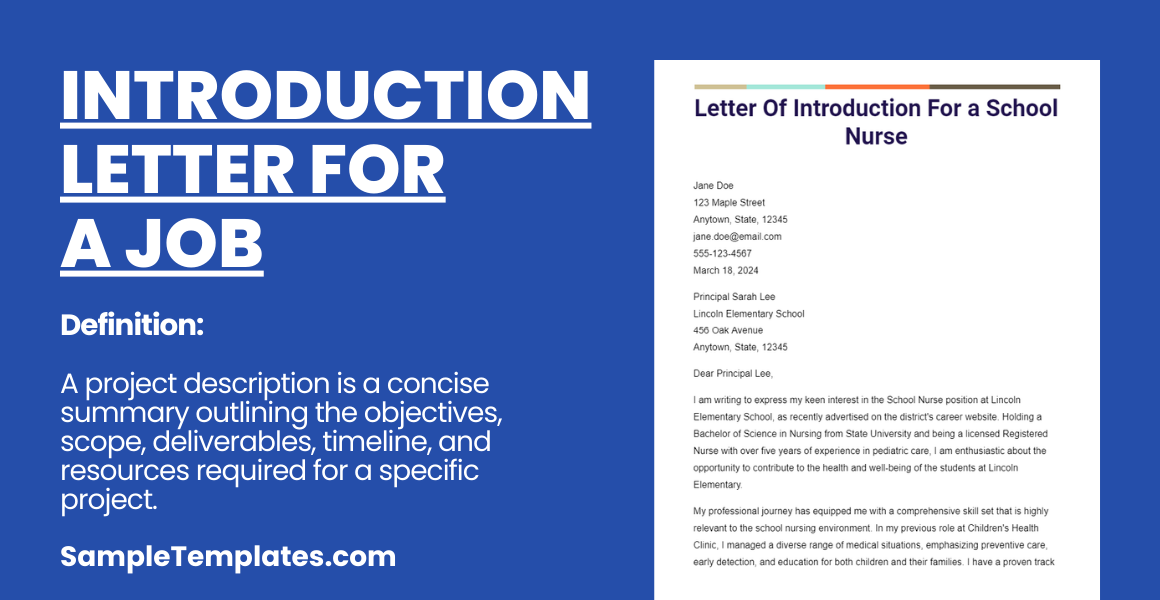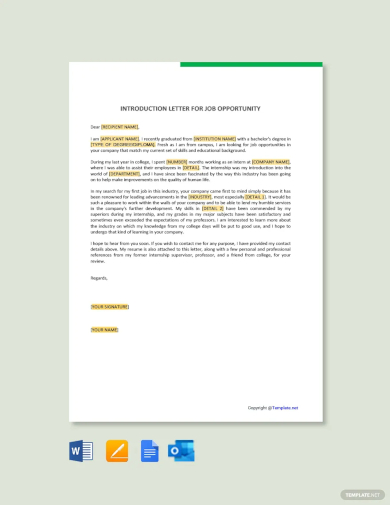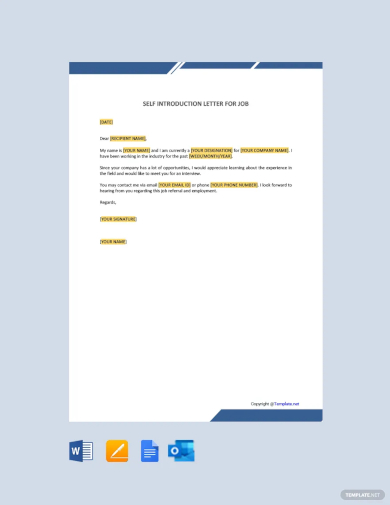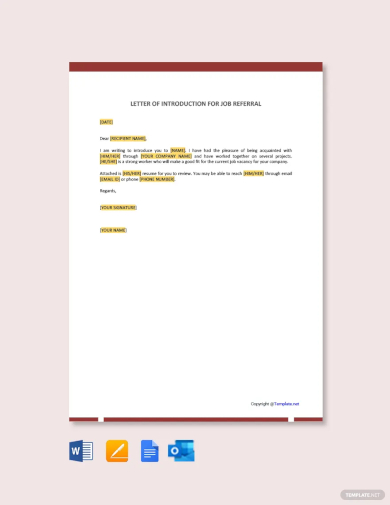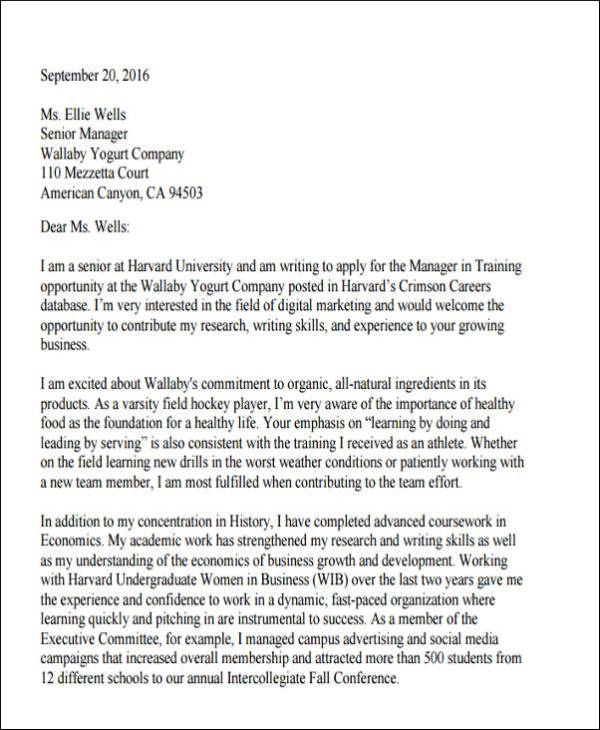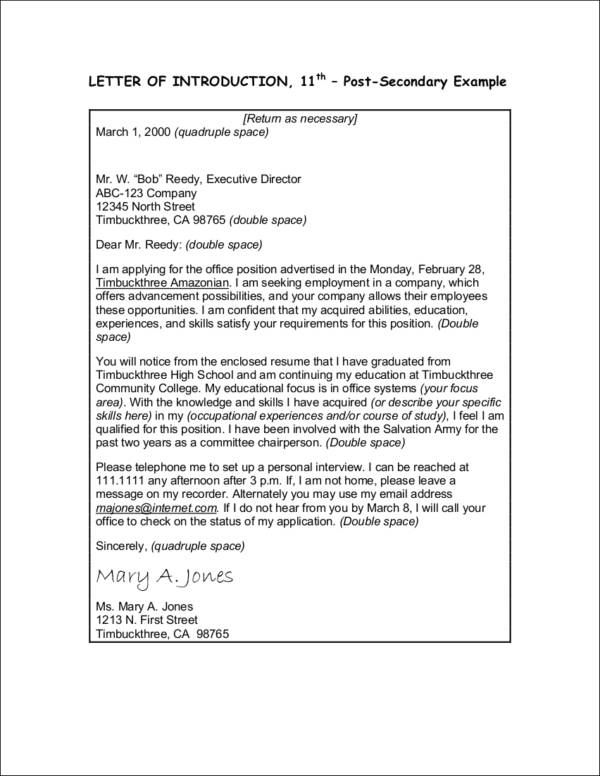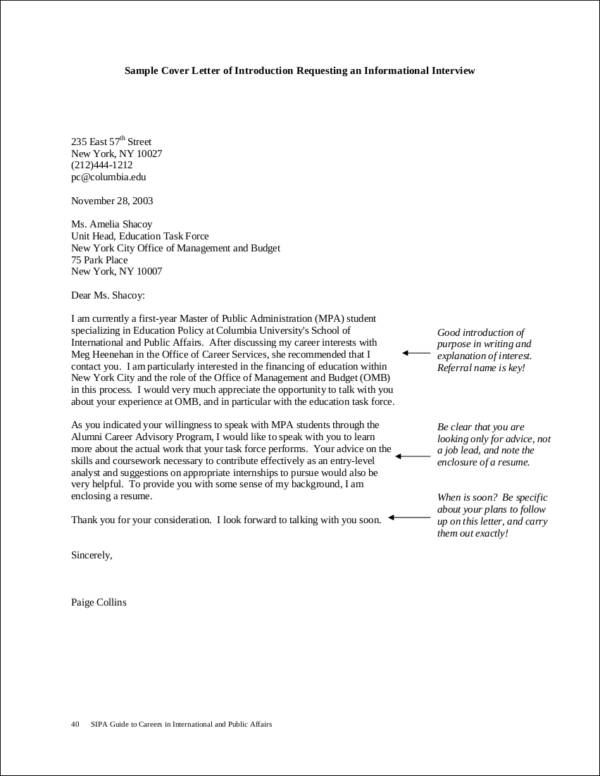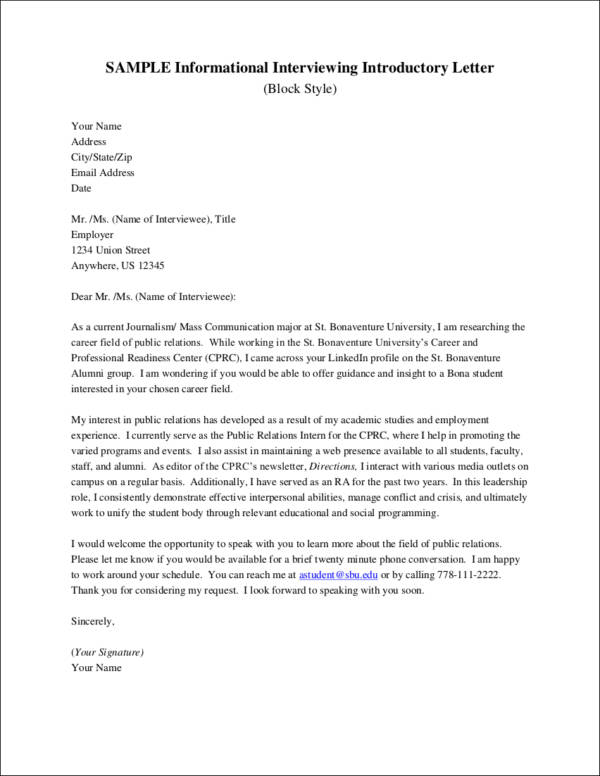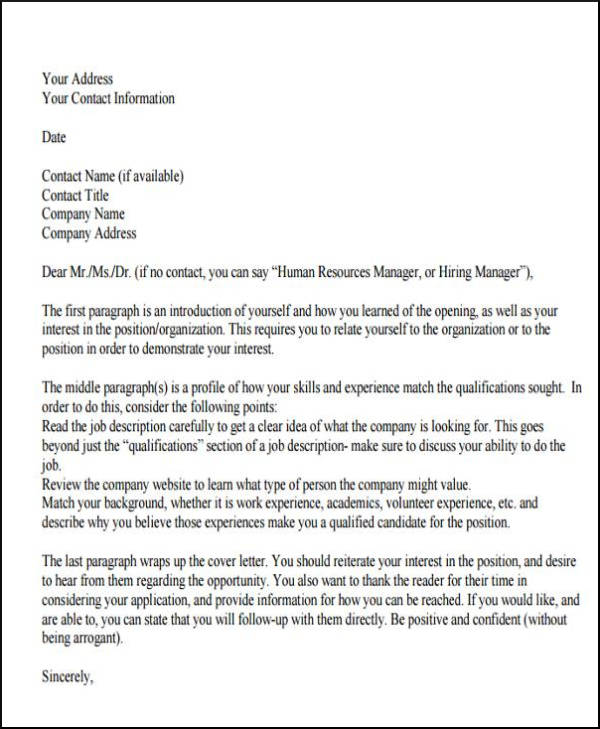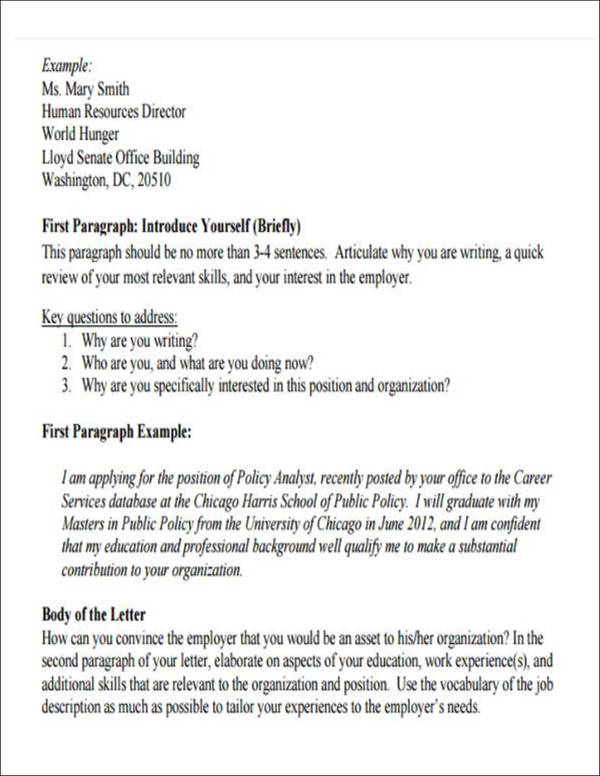It is common practice during job applications that cover letters for job applications are sent alongside an applicant’s resume. The main purpose of a cover letter is to introduce yourself to the organization, let them know that you are highly interested in the open position or that you are interested in being a part of the company’s workforce, and motivate the recipient to take a look at your resume/CV and other job application documents. But did you know that there is another type of letter that you can send with your job applications? Aside from cover letters, these letters that are called introduction letter for jobs. So what are introduction letters?
An introduction letter is a tool you can use to network when you are on the hunt for a job in the industry that you would like to be a part of. One way of getting hired is through networking. It does not matter if you know someone in the company or not. It is more of being able to present yourself to a company and forging a connection with them. To help you properly network yourself, we have a few tips and guidelines for you to follow in order to come up with an excellent introduction letter. We also have sample letters of introduction included in this article to give you a better understanding of what an introduction letter looks like. These samples are all downloadable for free and are very easy to use as they are in file formats that are familiar to almost everyone. Plus, they are compatible with a ton of mobile devices nowadays so you can refer to these samples on the go. Make sure that you keep reading to find out how to write an introduction letter and what are the tips that we have for you in order to make your letters very effective for your job search.
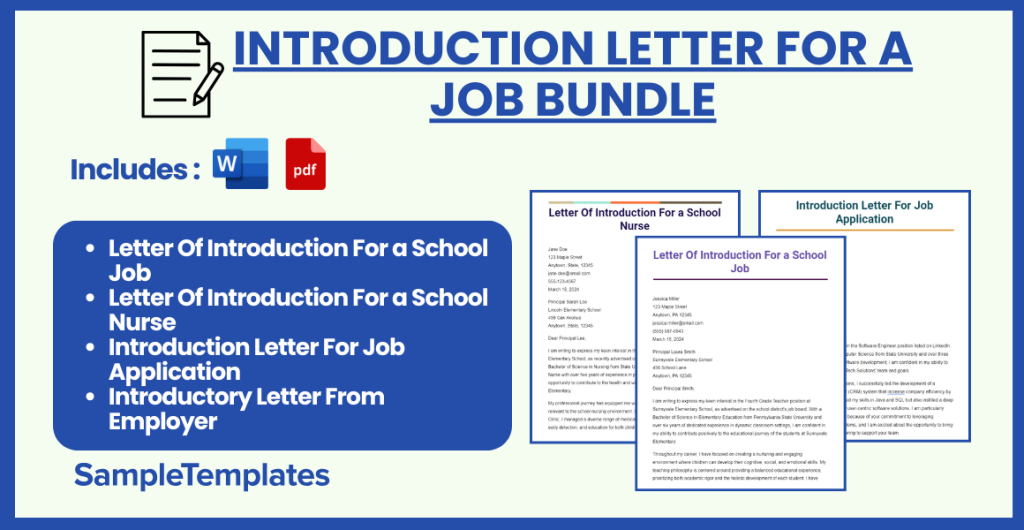
Download Introduction Letter For a Job Bundle
Letter Of Introduction For a School Job
Jessica Miller
123 Maple Street
Anytown, PA 12345
[email protected]
(555) 987-6543
March 18, 2024
Principal Laura Smith
Sunnyvale Elementary School
456 School Lane
Anytown, PA 12345
Dear Principal Smith,
I am writing to express my keen interest in the Fourth Grade Teacher position at Sunnyvale Elementary School, as advertised on the school district’s job board. With a Bachelor of Science in Elementary Education from Pennsylvania State University and over six years of dedicated experience in dynamic classroom settings, I am confident in my ability to contribute positively to the educational journey of the students at Sunnyvale Elementary.
Throughout my career, I have focused on creating a nurturing and engaging environment where children can develop their cognitive, social, and emotional skills. My teaching philosophy is centered around providing a balanced educational experience, prioritizing both academic rigor and the holistic development of each student. I have successfully implemented differentiated instruction and interactive learning strategies, significantly enhancing student participation and academic performance.
At Greenfield Community School, I was responsible for integrating technology into the curriculum and spearheaded a digital literacy initiative that profoundly impacted student learning outcomes. This experience honed my skills in curriculum development, classroom management, and educational technology, further fueling my passion for teaching and my commitment to fostering inclusive and innovative learning environments.
I am particularly impressed by Sunnyvale Elementary’s commitment to fostering lifelong learners and its emphasis on community engagement. I am eager to bring my background in experiential learning and my proactive approach to curriculum innovation to your esteemed team.
Enclosed is my resume, which provides further details about my educational background, teaching experience, and professional achievements. I am looking forward to the opportunity to discuss how my experience and vision can align with the needs and goals of Sunnyvale Elementary. I am available at your convenience for an interview and can be reached at (555) 987-6543 or [email protected].
Thank you for considering my application. I am excited about the opportunity to contribute to the continued success and growth of Sunnyvale Elementary and its students.
Warmest regards,
Jessica Miller

Letter Of Introduction For a School Nurse
Jane Doe
123 Maple Street
Anytown, State, 12345
[email protected]
555-123-4567
March 18, 2024
Principal Sarah Lee
Lincoln Elementary School
456 Oak Avenue
Anytown, State, 12345
Dear Principal Lee,
I am writing to express my keen interest in the School Nurse position at Lincoln Elementary School, as recently advertised on the district’s career website. Holding a Bachelor of Science in Nursing from State University and being a licensed Registered Nurse with over five years of experience in pediatric care, I am enthusiastic about the opportunity to contribute to the health and well-being of the students at Lincoln Elementary.
My professional journey has equipped me with a comprehensive skill set that is highly relevant to the school nursing environment. In my previous role at Children’s Health Clinic, I managed a diverse range of medical situations, emphasizing preventive care, early detection, and education for both children and their families. I have a proven track record of developing and implementing health plans tailored to individual needs, conducting health screenings, and providing emergency care.
I am particularly drawn to Lincoln Elementary School’s inclusive approach to education and its commitment to providing a safe and nurturing environment for all students. I am passionate about contributing to such an environment by offering comprehensive health services that support students’ ability to learn and thrive. My approach to school nursing goes beyond treating illnesses; it includes promoting healthy lifestyles, mental health awareness, and creating health education programs that benefit the entire school community.
Included with this letter is my resume, which further outlines my qualifications, professional experiences, and the specific initiatives I have led to promote student health and safety. I am eager to bring my expertise in pediatric nursing, health education, and wellness promotion to Lincoln Elementary School. I am confident that my background and dedication to student health will make a significant positive impact on your school community.
I look forward to the opportunity to discuss how I can contribute to the continued success and health of the students at Lincoln Elementary School. I am available at your convenience for an interview and can be reached at 555-123-4567 or via email at [email protected].
Thank you for considering my application. I am excited about the possibility of joining your team and making a meaningful contribution to the well-being of your students.
Warm regards,
Jane Doe
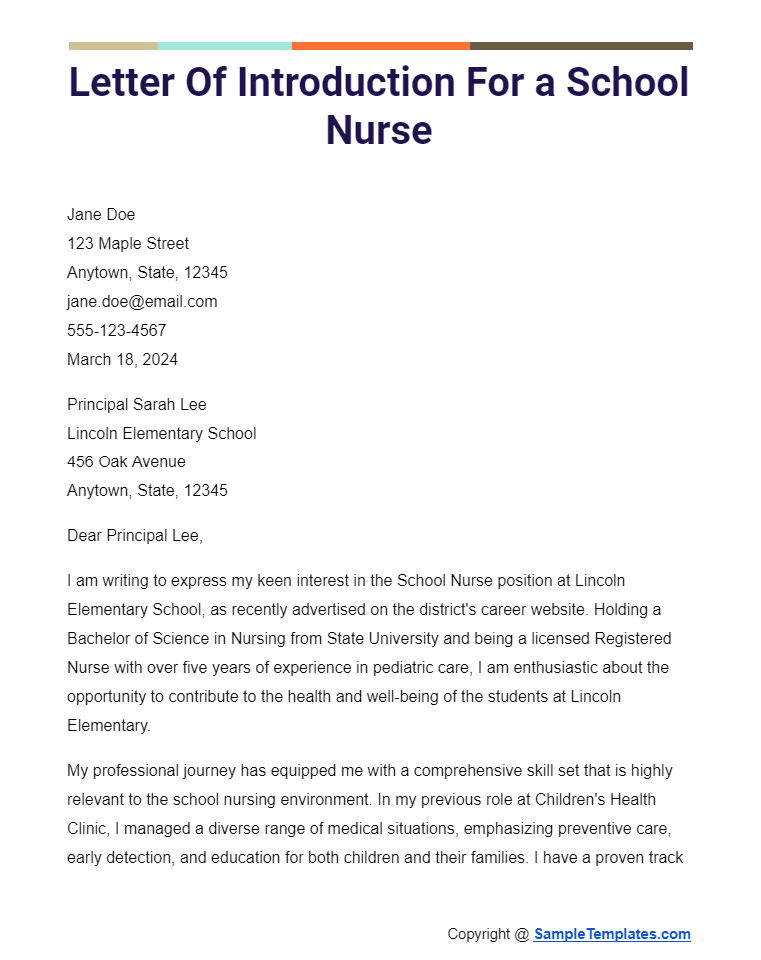
Introduction Letter For Job Application
David Miller
1234 Pine Street
Hometown, HT 56789
[email protected]
555-678-9101
March 18, 2024
Ms. Angela Hart
Innovative Tech Solutions
7890 Tech Avenue
Hometown, HT 56789
Dear Ms. Hart,
I am writing to express my interest in the Software Engineer position listed on LinkedIn. With a Bachelor of Science in Computer Science from State University and over three years of hands-on experience in software development, I am confident in my ability to contribute effectively to Innovative Tech Solutions’ team and goals.
In my previous role at Digital Creations, I successfully led the development of a customer relationship management (CRM) system that increased company efficiency by 25%. This experience not only honed my skills in Java and SQL but also instilled a deep understanding of the importance of user-centric software solutions. I am particularly drawn to Innovative Tech Solutions because of your commitment to leveraging technology to solve real-world problems, and I am excited about the opportunity to bring my background in software engineering to support your team.
I am known for my problem-solving ability, which enables me to tackle complex software challenges efficiently. At Digital Creations, my ability to think critically and collaborate effectively with cross-functional teams led to the successful launch of three major product updates, significantly enhancing user satisfaction.
Enclosed is my resume, which provides further detail about my professional achievements, skills, and educational background. I am enthusiastic about the possibility of bringing my unique talents to Innovative Tech Solutions and am keen to contribute to your team’s success. I am looking forward to the opportunity to discuss in more detail how I can add value to your organization.
Thank you for considering my application. I am looking forward to the possibility of discussing my application with you further and am available at your convenience for an interview.
Warmest regards,
David Miller
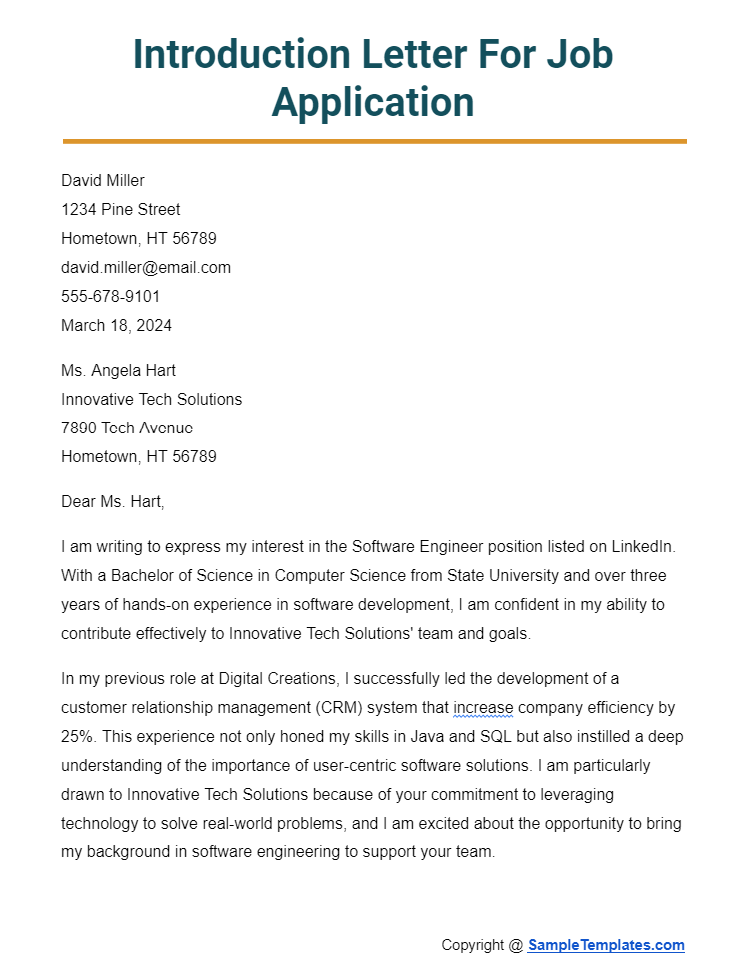
Introductory Letter From Employer
Jessica Harper
CEO
Harper Innovations Inc.
1234 Innovation Drive
Tech City, TC 8901
[email protected]
555-890-1234
March 18, 2024
Samuel Rodriguez
Procurement Manager
Global Manufacturing Corp.
5678 Industrial Way
Manufacturing Town, MT 4567
Dear Mr. Rodriguez,
I hope this letter finds you well. My name is Jessica Harper, and I am the CEO at Harper Innovations Inc., a company specializing in cutting-edge renewable energy solutions. I am writing to introduce our company and express our interest in exploring potential partnership opportunities with Global Manufacturing Corp.
At Harper Innovations Inc., we pride ourselves on delivering high-quality renewable energy products and have established a strong reputation in the industry for our sustainable and efficient solutions. Our team is composed of dedicated professionals who are committed to driving success and delivering value to our clients and partners alike.
We have been following Global Manufacturing Corp.’s achievements in sustainability initiatives, and we are impressed by your company’s commitment to environmental responsibility. We believe that a partnership between our two companies could be mutually beneficial, offering Global Manufacturing Corp. access to our innovative solar and wind energy solutions while allowing us to expand our reach and impact in the manufacturing industry.
I would be delighted to arrange a meeting to discuss how our companies might collaborate and explore ways to support each other’s goals. Whether it’s through a strategic partnership, joint venture, or another form of collaboration, we are open to discussing various possibilities that could lead to a prosperous relationship for both parties.
Please find attached a brief overview of our company, including our history, mission, and a summary of our renewable energy products. I would be more than happy to provide further information or answer any questions you might have.
Thank you for considering this opportunity. I look forward to the possibility of working together and to your positive response. Please feel free to contact me directly at 555-890-1234 or via email at [email protected].
Warm regards,
Jessica Harper
CEO
Harper Innovations Inc.
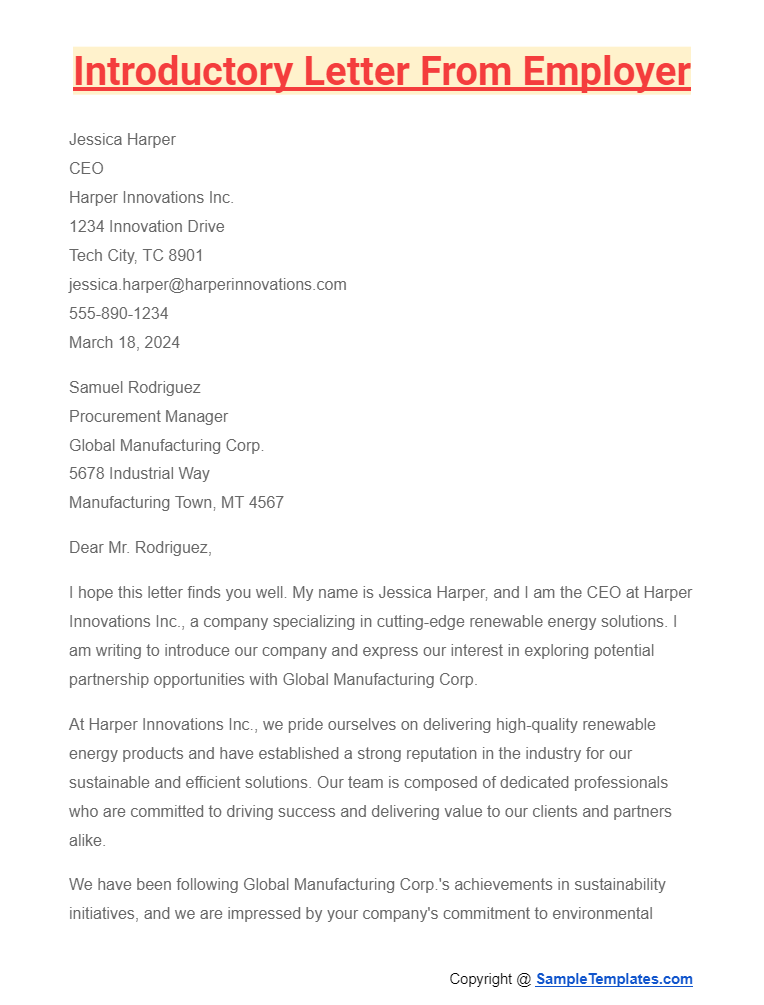
Browse More Templates On Introduction Letter for a Job
Free Introduction Letter for Job Opportunity Template
Self Introduction Letter For Job Template
Free Letter of Introduction for Job Referral Template
Letter of Introduction for Job Template
Personal Introduction Cover Letter Template
Sample Portfolio Letter of Introduction Template
Letter of Introduction for a Job Template
Introduction Letter to Employer Template
Formal Letter of Introduction for a Job Template
Cover Letters vs. Introduction Letters
The thing is, aside from thinking about what to put in your resume, you should also think about making your job-related letters as solid as your resumes. Your letter will be the first thing that a hiring manager will take a look at anyway, so be sure to craft it well.
“Is there a difference between a cover letter and an introduction letter?” This is probably one question that might be boggling your mind right now. So before we start telling you what you need to know about introduction letters, let us briefly discuss what makes these letters different from cover letters.
There is a subtle difference between the two letters. A cover letter is typically sent when you are responding to a job advertisement, whereas an introduction letter is typically sent cold or if you are not responding to a particular or specific job posting. However, both sample letters aim for the same thing: to give the hiring managers a good glimpse of what you can bring to the table. But for cover letters, you will be able to directly address what it is that the company is looking for.
So now that you know what the difference between the two are, it is now time to determine whether you will make use of an introduction letter or will start crafting a standout cover letter. If you feel like an introduction letter is appropriate for your job-hunting needs, then just continue reading this article!
Types Of Introduction Letters

Introduction letters serve various purposes depending on the context and the relationship between the sender and recipient. Here are four common types of introduction letters:
1. Professional Introduction Letter
This type is used in business settings to introduce oneself, a colleague, or a company to potential clients, suppliers, or business partners. It aims to establish a professional relationship, highlight expertise or services, and set the stage for future interactions. These letters are often used during networking, exploring new business opportunities, or when someone joins a new company and wishes to introduce themselves to clients or stakeholders.
2. Job Application Introduction Letter
Also known as a cover letter, this accompanies a resume when applying for a job. It introduces the candidate to the employer, highlights key achievements and skills, and expresses the candidate’s interest in the position and the company. The goal is to persuade the employer to consider the applicant for the job by showcasing how their background and aspirations align with the job requirements and company culture.
3. Personal Introduction Letter
Used in informal or semi-formal contexts, this type of letter introduces a person to another individual. It could be used for making new friends, introducing a family member to a social group, or establishing a new contact within a community. The letter usually includes basic personal information, interests, reasons for the introduction, and any connections or mutual interests that might foster the new relationship.
4. Student Introduction Letter
This letter is used by students to introduce themselves to teachers, professors, or classmates, especially in scenarios like a new school year, a college application, or joining a new academic program or club. It can outline the student’s academic interests, achievements, and goals, as well as personal hobbies or extracurricular activities, facilitating a better understanding and rapport within the academic environment.
Each type of introduction letter serves a unique purpose and should be tailored to fit the specific context and relationship it seeks to establish or enhance.
Writing Your Introduction Letter
Now that you know what the common types of introduction letters are, it is high time you start writing your letter. It is important to take note that your introduction letters need not be lengthy and should also be straight to the point.
Now, let’s get started with your introduction letter!
- Introduce yourself. Briefly introduce yourself to the recipient. Note that in your introduction, you will also be letting the recipient know how you got to know about the company—whether it be through a common connection or if you have seen job ads or postings around. If you knew of the company or the open position through a referral, do not hesitate to drop his/her name, but make sure you asked for permission to do so. State the preferred position you want to be in. Immediately let them know why you are the best candidate for this position. You want them to be curious about you and be encouraged to start browsing through your sample resume or CV.
- Let them know what your purpose is. Are you looking to apply for a job in the company? Are you hoping to get an interview? Set your goals straight and be as straightforward as possible. Letting them know what you hope to accomplish through the letter makes it easier for them to understand what you want and they will likely invite you over for an informal interview. Expand on your qualifications and experiences in this part of the letter. Make it seem like you are the perfect applicant for the company. Incorporate some of the things that you have researched about the company and relate it to your own qualifications, education, experiences, and accomplishments.
- Close strong. Include a strong statement in your concluding paragraph. Restate that you are going to match well with what the company is looking for and with the company’s culture. If you have completed the requirements for the job applications, do not hesitate to state it in your letter as well. You should also let them know when you are going to follow up should you not hear from them after a few days.
- Leave your contact information. Make it easy for the recipient to communicate with you. Leave your primary contact details such as your mobile or home phone number, current address, and email address.
Formatting Your Introduction Letters
Make use of a proper business letter format for your introduction letter. Since these letters are business-related, you need to be aware of what you include in your letter. Remember to keep the tone of your letter as professional as possible. You should also remember to be straight to point and avoid keeping these letters too lengthy.
A few simple formatting tips about introduction letters are as follows:
- Whether you are printing a copy of your letter or sending/uploading it as an attachment, keep the size to A4 or letter (8.5″ × 11″).
- The tone and language of the letter should be uniform all throughout from start to end.
- The letter should be kept simple and precise.
- You should also remember to go over your letter several times to ensure that you avoid any mistakes such as misspellings and grammatical errors.
Cover Letter of Introduction Requesting an Informational Interview
Sample Informational Interviewing Introductory Letter Template
Company Introduction Cover Letter Template
Self-Introduction Cover Letter Format
New Job Introduction Letter Template
Quick Tips to Knowing What to Include in Your Introduction Letter
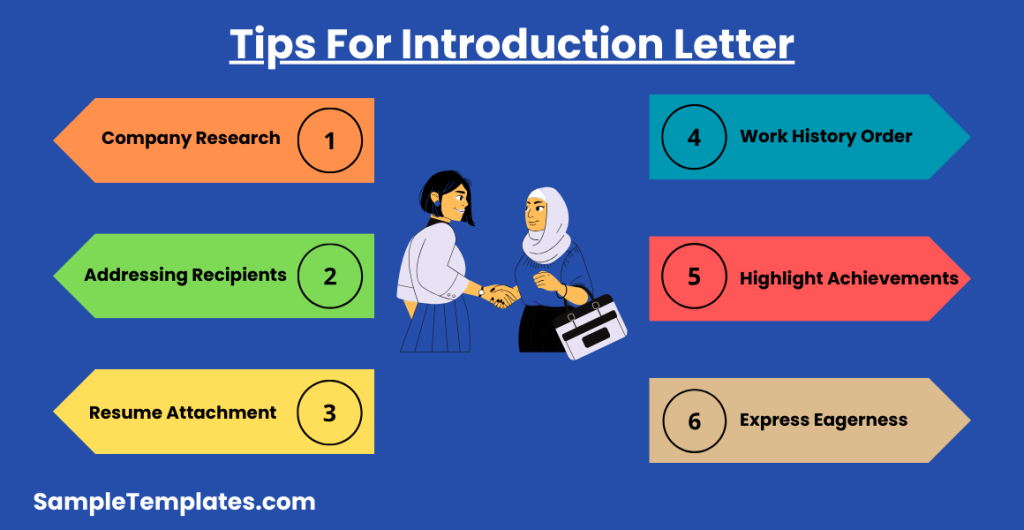
Introduction letters can take the place of a cover letter and resume when you are using it as a means of networking to applying for jobs. These letters serves as a great way of assessing whether you will be a good match for the company. It should be able to showcase what your expertise and background are despite being short in nature. It is also a good avenue for you to showcase your communication skills.
- Do a quick research about the company. When you start researching about the company, make sure that you determine who the main recipient of your letter is. Remember, you want to make a good impression. Knowing who to send the letter to is actually a subtle way of making a good impression. A properly addressed letter will always sound better and look better compared to a letter that has a generic heading. Do not forget to use the proper title as well if they have titles to their names.
- Send a copy of your job resume alongside your introduction letter. Sending your job resume with your introduction letter makes referencing easier and it will also give the recipient a better glimpse of what you can do for the company. Remember that presenting your experience and qualifications strengthens your chances of getting an interview.
- Present your work history in a reverse chronological order. Start with the most recent ones going down to the earlier ones. However, remember to only include the ones that are relevant to the industry of the company you are writing the letter.
- Include your accomplishments. Make use of bullet points to make it easier for the recipient to read your letter. It gives the recipient a good view about what your success and capabilities are.
- Give an explanation as to why you believe your qualifications will be a good fit with the company’s culture. Always let them know how they can benefit from you becoming a part of their workforce.
- Let them know about your schedule. If possible, give the recipient a brief schedule of when you might be available for an interview. This will to let them know how to prioritize you and sample schedule you according to your availability. Also, let them know if you will be available for relocation should the nature of the job require you to do so.
- Let them know that you are looking forward to meeting with them. Your eagerness and interest in the job or in the company is a good plus to get you considered for the position. Invite the recipient to get in touch with you and invite you for an interview to discuss any queries they might have about you.
So there you go! We hope that cleared your mind up even just a little bit about what introduction letters are. We also hope that the sample letters of introduction to download for free also made your letter-writing task a tad bit easier. Give it a shot and adjust accordingly.
What is an example of a letter of introduction?
Dear [Recipient],
I am writing to introduce myself as [Your Name], [Your Position]. With [number] years of experience in [relevant field], I am excited about the opportunity to contribute to [company/organization]. Sincerely, [Your Name].
How should you introduce yourself in a letter?
In a letter, introduce yourself with your name, relevant background or qualifications, and the purpose of the communication, succinctly conveying your interest and intent.
How do you write about yourself professionally?
When writing about yourself professionally, focus on highlighting relevant skills, experiences, and achievements. Use clear and concise language to convey your qualifications and expertise effectively, tailored to the audience’s needs and interests
What is a good self introduction paragraph?
“Hello, my name is [Your Name]. I am a [Your Profession/Interest] with [number] years of experience in [relevant field]. Passionate about [specific interest], I thrive on [specific quality or accomplishment].
What is a personal introduction letter?
A personal introduction letter is a written communication used to introduce oneself to someone for various purposes, such as networking, job applications, or establishing professional relationships, typically detailing background, skills, and objectives.
Start writing those letters now and remember to customize your letters for every job industry you intend to apply for. If you do not hear from the employers, do not forget to follow up. Remember that employers are quite busy with a lot of things and they might unintentionally forget to give you sample feedback about your application. If you ever encounter a rejection, just keep your head up and keep moving forward. It will never be the end of the line, especially if you do not stop trying. Just keep sending those job applications. We wish you all the best with your job search!
Related Posts
Resignation Letter for Medical Samples & Templates
Letter of Intent Samples & Templates
Letter of Intent for a Job Samples & Templates
Lease Proposal Letter Samples & Templates
Letter of Inquiry Samples & Templates
Character Reference Letter Samples & Templates
Claims Letter Samples & Templates
Response Letter Sample & Templates
Follow Up Letter Samples & Templates
Sample Project Proposal Letter Templates
Donation Letter Samples & Templates
Addressing a Formal Letter Samples & Templates
Grievance Letter Samples & Templates
Sample Sponsor Thank You Letter Templates
Sample Letters of Request
